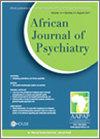Lilliputian hallucinations in schizophrenia: a case report.
引用次数: 2
Abstract
Lilliputian hallucinations are a rare type of visual hallucination where imaginary objects, persons or animals of diminutive size are perceived. These small images are usually described as brightly coloured mobile creatures. The earliest description was given by Macarius in 400 AD who described these as 'little strangers', but the term 'Lilliputian' was first used by Leroy. Lilliputian hallucinations have been described in a variety of clinical conditions such as delirium, dementia, alcohol withdrawal states, following intake of dihydrocodein phosphate and dl-methylephedrine hydrochloride (a cough syrup), and medical conditions like toxoplasmosis, basilar migraine, mesencephalic lesions, cerebral tumors, epilepsy, Charles Bonnet Syndrome, and trichloroethylene poisoning. Lilliputian hallucinations were first described in schizophrenia by Lewis, but have been reported as a rare phenomenon.精神分裂症的小人国幻觉:一例报告。
本文章由计算机程序翻译,如有差异,请以英文原文为准。
求助全文
约1分钟内获得全文
求助全文

 求助内容:
求助内容: 应助结果提醒方式:
应助结果提醒方式:


